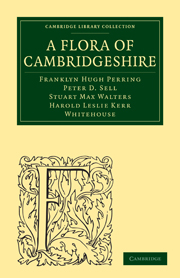Book contents
FOREWORD
Published online by Cambridge University Press: 03 May 2011
Summary
To produce a new Flora of Cambridgeshire is to be responsible for accepting a great tradition and adding to what may well claim to be the most famous sequence of local taxonomic records in the world. When the present volume was planned it was hoped to publish it in the tercentenary year of John Ray's Catalogus Plantarum circa Cantabrigiam nascentium published in 1660 and marking not only its author's entry into the study of natural history but the first scientific treatment of our native plants. Ray's book records a large number of species new to botany and gives first lists of plants found in particular types of localities, the lanes of Chesterton and Ditton, the chalk of the Gog Magogs and Cherry Hinton, the woods of Madingley and Kingston, Newmarket Heath and the Devil's Dyke and the fens at Teversham and Stretham ferry. How thoroughly he observed is witnessed by the fact that several species are still only found in the place where he discovered them, and one, Veronica spicata, which he recorded as ‘in a close near the beacon on the left hand of the way from Cambridge to Newmarket in great plenty’, was lost from his day till after much research Dr W. H. Mills rediscovered it in the thirties.
Since Ray's time the Cambridgeshire plants have been resurveyed by Charles Cardale Babington, Professor of Botany in 1860–a careful and accurate record giving for the first time lists of some of the ‘difficult’ genera–a worthy successor to the Catalogus;, and by A. H. Evans, a keen field-naturalist who brought the records up to date in 1939.
- Type
- Chapter
- Information
- A Flora of Cambridgeshire , pp. ix - xPublisher: Cambridge University PressPrint publication year: 2009First published in: 1964



